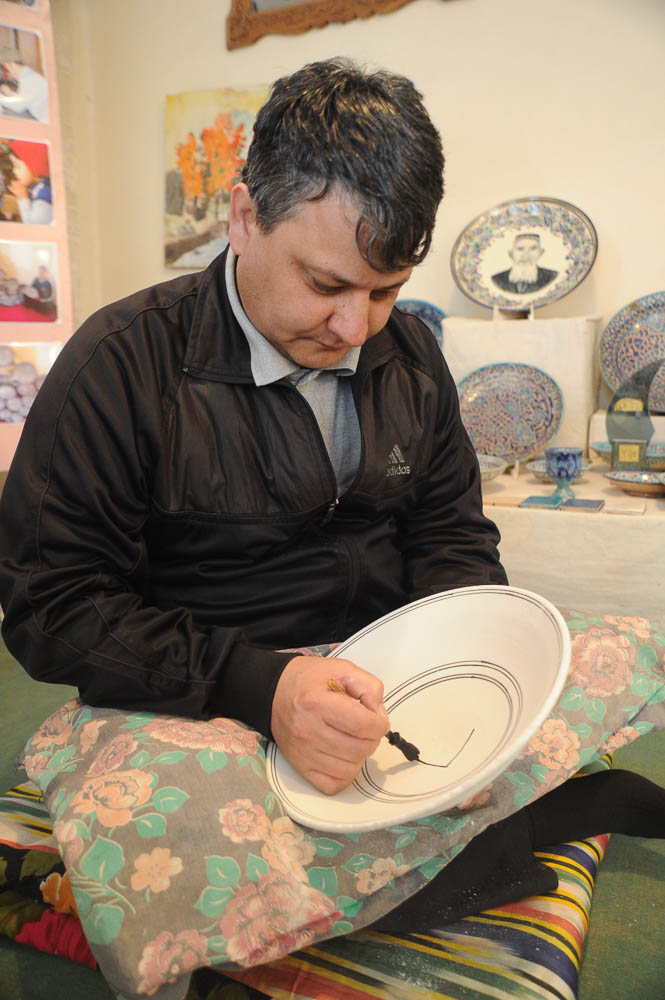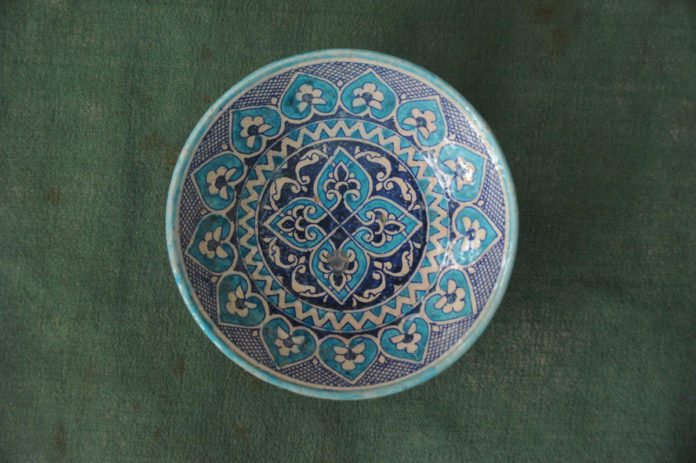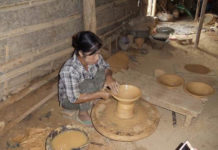One of the most ancient and interesting areas of applied art in Uzbekistan is ceramics.
Ceramics is divided into two main types—non-glazed and glazed. Non-glazed ceramics has deeper roots. Since the end of the eighth century and the beginning of the ninth century, in the cities of Maverannahr, glazed ceramics started to appear and begin wide dissemination. During the ninth to the eighteenth centuries, it attained a high degree of artistic perfection and high technical quality.
In the nineteenth century the main schools and centers of ceramics developed in Uzbekistan were: a) the Samarkand-Bukhara school with centers in Tashkent, Samarkand, Urgut, Bukhara, Gizhduvan, Shakhrisabz, Kitab, Kattakurgan, Denau; b) the Fergana school with centers in Rishtan and Gurumsaray); the Khorezm school including centers in Khiva, Madyr and Kattabag villages, and in Chimbay.
Artists carefully selected clay in the area, which are usually located not far from their workshops. For making of the products they used pottery wheel (charkh). Many masters prepare clay for pottery wheel roughly the same way. Master kneads the clay with feet first, and then with his hands. Then, throws prepared piece of clay (gunt) on a wheel and starts to turn it around and around with feet and with hands to give to clay a desired shape. Once the product is ready, the master cuts it at the bottom and leaves the product to dry. The next step is the application of a pattern and glazing.
 Ceramics of each center maintained its local features. The blue color that was associated with the use of ishkor (alkaline) glaze, which gives a blue tint decoration after firing dominated in Ferghana and Khorezm ceramics. However, the content of the decor, the type and range of ceramic products of these two centres differ from each other. Ceramics of Bukhara-Samarkand school had an ochre-yellow and greenish color that was associated with the use of lead glaze. By composition, patterns and types of products, it is closer to the Fergana school of ceramics.
Ceramics of each center maintained its local features. The blue color that was associated with the use of ishkor (alkaline) glaze, which gives a blue tint decoration after firing dominated in Ferghana and Khorezm ceramics. However, the content of the decor, the type and range of ceramic products of these two centres differ from each other. Ceramics of Bukhara-Samarkand school had an ochre-yellow and greenish color that was associated with the use of lead glaze. By composition, patterns and types of products, it is closer to the Fergana school of ceramics.
By the middle of the twentieth century a number of ceramics centres ceased to exist; technological and artistic traditions were lost. In the early twenty-first century, a number of centres of glazed ceramics (Shakhrisabz, Baysun) were restored, the conditions for successful distribution of ceramist’s products were set-up and a system of apprenticeship in ceramics was established. Today, traditional ceramics are made in such centers as Rishtan, Gurumsaray, Andijan, Tashkent, Bukhara, Samarkand, Urgut, Gizhudvan, Denau, Baysun, in Madyr and Kattabag villages near Khiva. Many of the leading ceramists received high ranking. Among them is a number of National artists, Honoured Masters of Arts and Academicians. Thus, the title of Academician of the Academy of Arts of Uzbekistan was conferred on Sharafiddin Yusupov, from Rishtan, Alisher Narzullaev from Gijduvan, Akbar Rakhimov from Tashkent, Sh.Azimov and H.Hakberdiev from Samarkand. The products of modern masters of Uzbek ceramics have great demand. This is demonstrated in exhibitions and sales in art galleries and markets. Products of Uzbek ceramics are sold abroad as well, such as in Europe, Russia, Kazakhstan, the United States and Canada.





